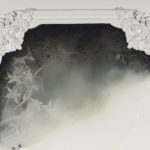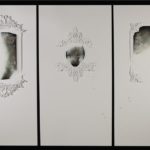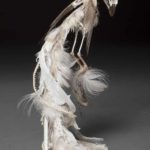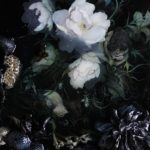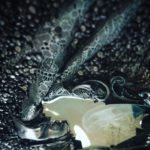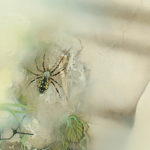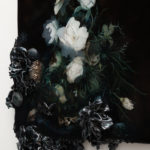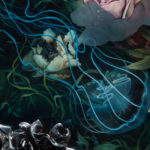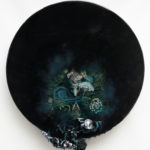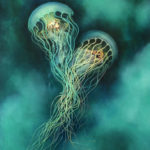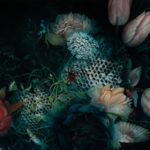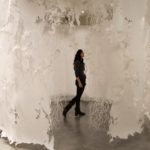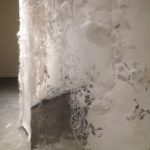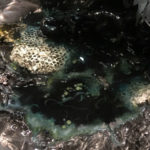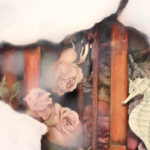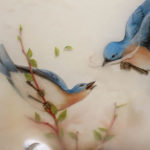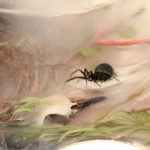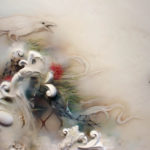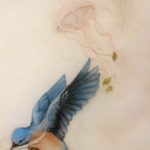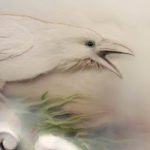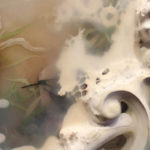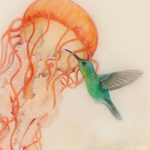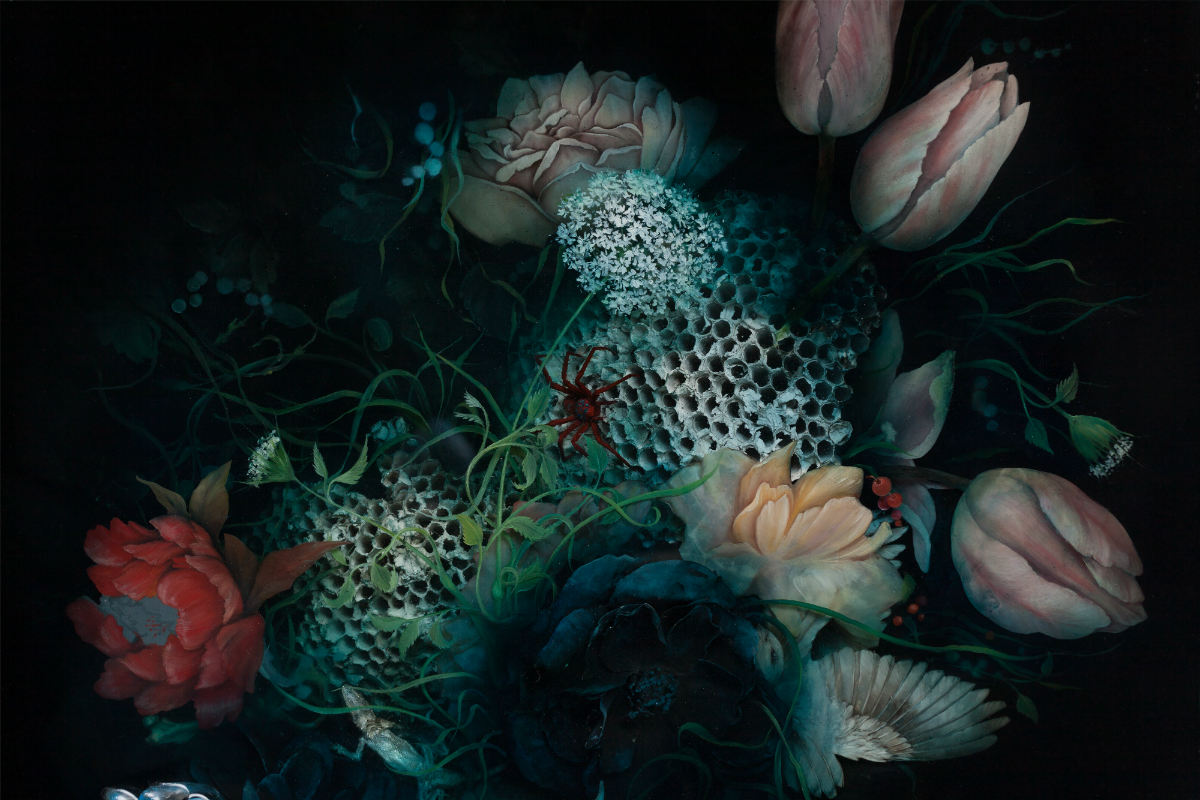
ARTIST BIO
Regan Rosburg is an artist and naturalist. Recently, her work has been an investigation into society’s collective grief, melancholia and mania, which she defines as consumption and distraction.
She has conducted biology-based research trips to the Bahamas, Canada, Costa Rica, Indonesia, Thailand, the Pacific Northwest coast, and the Smokey Mountains of northeast Tennessee.
Rosburg works in a variety of materials. Her resin work contains precious artifacts: plant and animal relics, bones, insects, lace and painted imagery. With slow, painstaking care, the artist suspends these objects in three-dimensional resin “paintings.” While presenting the beauty of plant and animal species, she is poignantly addressing her growing concern over plastic pollution in the environment. Due to the complicated, labor-intensive resin process, her body of work over several years is small.
Recently she has added mylar installations and resin sculptures to her arts.
INTERVIEW
Artist: Regan Rosburg
Do you remember the earliest memory of when you wanted to do what you do today?
My earliest memory of connecting nature to art was when I won an Arbor Day coloring contest in Kindergarten, and they awarded me a small tree. Our family planted the tree on my family’s property in Colorado Springs, and I see it every time I go home.
How does pollution and plastic impact in your artistic projects?
Because I am a nature lover, I have witnessed how pollution is affecting areas all over the world, big and small, far and wide. The first time I was truly shaken was when I was 25 years old, watching plastic wash up on beaches off the coast of Thailand. That was at the beginning of the plastic deluge, and it stuck with me for years. Because I make paintings out of plastic and natural objects, I must take responsibility for my materials and my methodology. I try to stay away from making “stuff” and instead aim to make small bodies of work or large installations that provide visitor interaction and contemplation about these bigger questions and issues.
What is the best part about creating art using various art supplies and found objects? How is to combine elements like precious artifacts bones, feathers, lace, insects, shark’s teeth, pheonix feathers, ivory, resin, lacemetal and plastic?
It is challenging, the mediums I work with. Resin is not forgiving, and it has taken me the better part of two decades to perfect my methods. That said, my materials are allowed to showcase these gorgeous relics of lives that have past. I am not usually grossed out by cleaning my bones and skeletons, or by spreading insects. To me, I am honoring their lives, and recreating a permanent home for their spirits.
Do you have any favorite pallet of colors?
I am very much into black lately… It has to do with the void I feel, the inherent sadness, the mourning. But it also represents a vast potential, a backdrop of possibility.
How do you balance your own activities as a sculptor, painter jewelry maker, writer, professor , critic, activist and , curator?
Oh geez… well I am constantly switching but I have learned to focus on small projects, and to do that small project as well as I can. I do not make jewelry anymore, it felt too commercial. Teaching my students at the university is immensely rewarding, and I try to cultivate their critical thinking skills, and get them to relate their projects to the changing world around them. As for everything else, I simply do my best with what is asked of me, and see how best I can be of service to others with my work, activism, and research.
Given that you live and work between Denver Bahamas, Canada, Costa Rica, Indonesia, Thailand, The Pacific Northwest Coast, and the Smokey Mountains of Northeast Tennessee, may geographical and cultural surroundings impact your artistic process?
Absolutely! Each time I travel I learn more how people are alike/different, and how ecosystems survive/struggle in these crazy times. I am on the hunt for new places to explore all the time. I have my eye on the northern regions of the earth right now.
Vanitas, which contained symbols of death or change as a reminder that all living things succumb to their own mortality. In which context does Vanitas come in your work?
Excellent question. In essence, all of my work is a Vanitas in concept. My materials address the permeable wall between death and decay, and life and existence. Every single person, animal, and plant that has ever existed has been on the same massive ball of magma and dirt that we all stand on right now. I find the idea and notion of Vanitas has become something of a sickness in our way of living. We are so terrified of death that we distance ourselves from it, and in so doing, we distance ourselves from the rich teachings that experiencing grief can give us. When you truly grieve something, it is because you truly love it. With our busy lives, our many options of avoidance/mania/desperatio, we are not fully experiencing the LOVE for the beauty of this earth, the long evolved processes that have interlaced into a superbly sensitive network of life… its all around us, and yet we do not see. Our vanity has perverted itself into consumption, and that is killing the planet.
Your work also investigates the concepts of environmental melancholia and what it’s call “collective social mania.” How can you explain that?
When you do not properly mourn something, you are not able to grieve it’s passing. When this goes on long enough, you might enter what is known as “melancholia.” Renee Lertzman coined the phrase “environmental melancholia” to describe the unresolved, unmourned feelings related to overlapping environmental events. Basically, many things are dying on the planet, and we cannot possibly mourn all of them. We are too out of touch with our emotions. But the business, to me, is the other side of the issue. I call it “collective social mania” and it is basically all of the things we do to distract ourselves from feeling any pain, guilt, sadness or grief related to the environmental collapses around us. Our drive to forget, and to forget by consuming, is causing the environmental collapse that we are trying to escape. It is a vicious cycle that I outline in my research paper, “The Relentless Memorial.”
The good news is, art can stop the cycle. Art can reconnect us with the world, our emotions, and our responsibility.
What legacy would you like to leave behind?
I want to connect people back to themselves and to the Earth via my art, and by helping other artists do the same. We are an army, growing larger everyday, fighting the good fight. Currently I am working on multiple projects, including a huge commission about an endangered bird in Michigan, a 2019 show in Halifax Nova Scotia dedicated to art.
Click the images to see full size.
